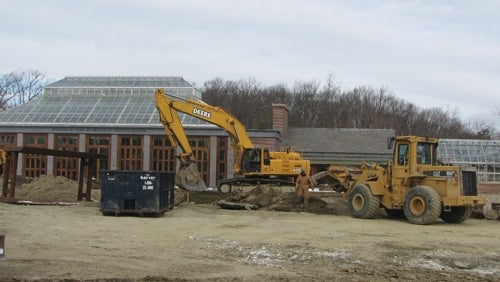John Trexler, executive director of the Tower Hill Botanical Gardens, has been planning and fundraising for a major addition and renovation to the 132-acre facility in Boylston since about 2004.
“We were going to begin construction in mid-2008, but construction prices were just prohibitive,” he said. “So we decided to wait.”
It paid off — literally.
Trexler said the 14,000 square feet of new construction began in the spring of 2009 and with contractors hungry for work, he estimates the organization saved about $1 million on the $7 million project.
“It was considerably less than the projected cost from a year and a half ago,” he said. “We were just lucky enough to have all our ducks in a row when the market was right and we were able to take advantage.”
Market Timing
For public and private organizations that are able to commit funding for construction projects, contractors are reporting prices are 10 to 20 percent lower compared to similar jobs about a year and a half ago.
Materials prices are lower, in some cases labor costs are lower, and many contractors and subcontractors are dipping into margins in an effort to beat out the increased competition.
However, those low prices may not last forever. The Producer Price Index, according to the Bureau of Labor Statistics, rose by 2 percent in November compared to a year earlier. That was the first time in 12 consecutive months that the price of finished goods rose compared to the previous year.
Jim Madigan, co-owner and treasurer of F.W. Madigan Co. in Worcester, said pricing has a trickle-down effect.
When a contractor such as Madigan is hired, the company then hires subcontractors to do trade-specific work, such as plumbing and electrical. Madigan said subcontractors can sometimes account for as much as 80 percent of the work on a project, under the supervision of the general contractors.
And the economy has pushed subcontracting prices down to some of the lowest Madigan has ever seen.
Not only are subcontractors offering lower bids, but there are more subcontractors bidding on jobs, and they come from a wider geographic region.
Whereas Madigan use to work with two or three contractors per trade on a regular basis, now he gets bids from subcontractors across New England.
“That’s really driving prices down,” he said.
Ted Goodnow, president and founder of Woodmeister Master Builders, a luxury homes developer in Holden, said he estimates prices in residential construction are down similar amounts.
There’s been a shift, he said. Clients are looking to bid out more work, searching for the lowest prices from reputable contractors and subcontractors.
“They really want to make sure they’re getting the best value from the general contractor,” he said. “They certainly don’t want to overspend in this market.”
Goodnow said work has slowly started to pick up in the last four to six months, and backlogs are starting to build up again.
Public projects have benefitted from the competitive market, too.
When two school roofs needed to be replaced in Fitchburg, officials went to the city council for a $700,000 loan order to pay for the project, which councilors eventually agreed to.
Normal contracting projects see a handful of bids, but this one in the late summer saw more than a dozen, with the low bid priced at $408,000, almost $300,000 less than the estimated cost.
“The benefit is, hopefully we can do more projects with the same amount of money,” said Fitchburg Public School Business Manager Robert Jokela.
The state has also benefited from the competitive market, according to Kevin Flanigan, deputy director of the Division of Capital Asset Management, which handles construction projects for most state executive-level departments.
On the 15 projects worth $1 million or more DCAM put out to bid last year, there was a 30 percent difference between the awarded amount and the pre-bid estimate.
Despite the low prices and competitive market for construction jobs, the fact remains that many public and private organizations don’t have the financing, or do not want to commit financing for construction projects now.
Vance Freymann, director of project development for Consigli Construction in Milford, said he knows there will be a turnaround in construction at some point, he just doesn’t know when. He said the indicator will be when architectural firms begin to get busy, then, usually six to eight months later contractors start getting jobs.
He’s also hoping state investments in school building projects and federal investments through the stimulus will help keep contractors busy while the private market recovers.

